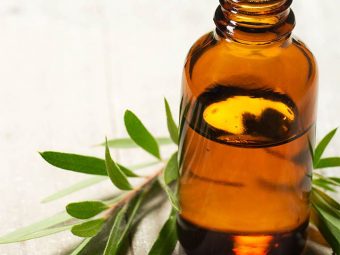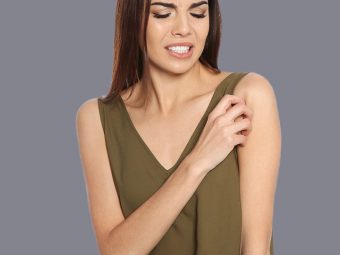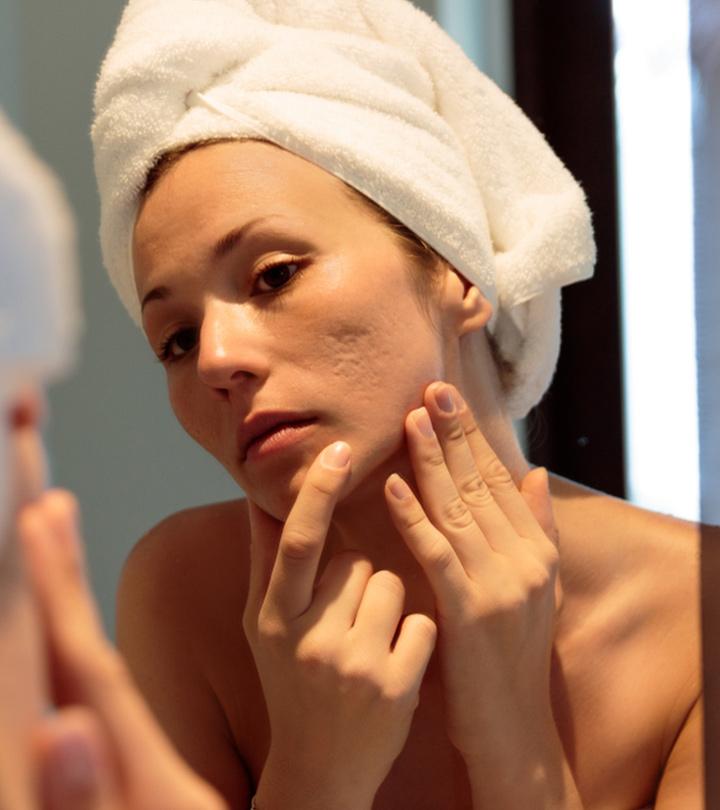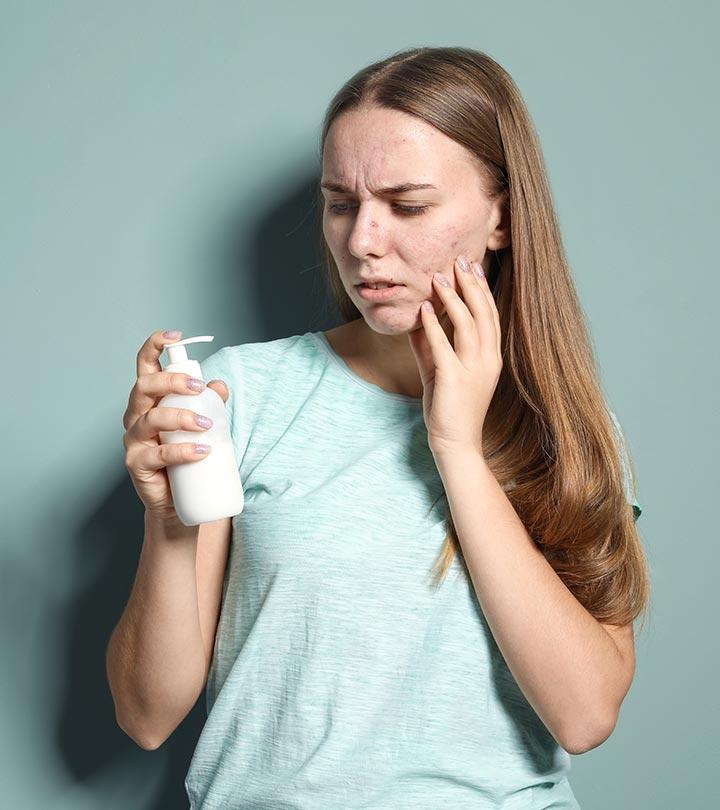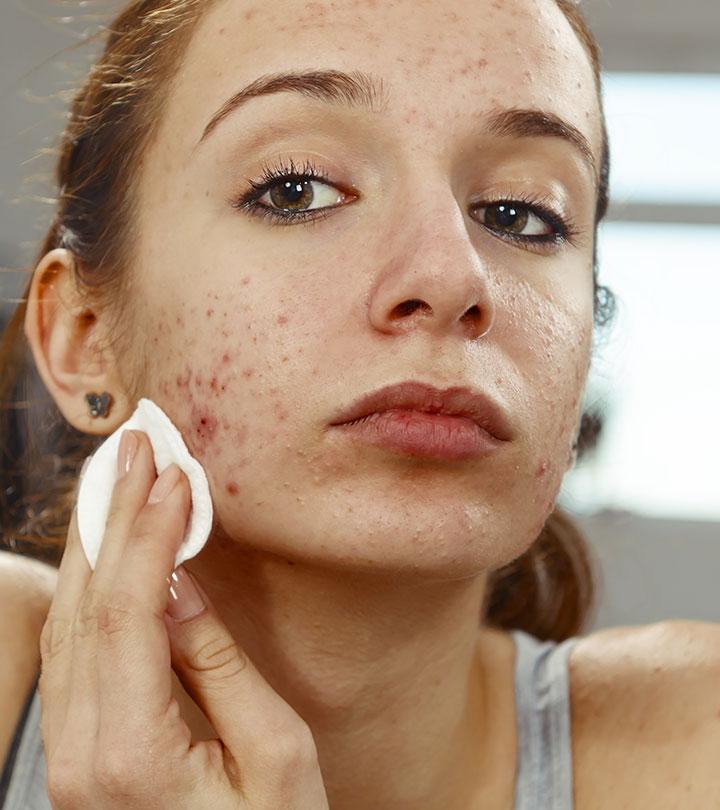Does Tea Tree Oil Help Treat Keloids?
Use the therapeutic properties of this potent oil to reduce the scars on your body.

Image: ShutterStock
Keloids can be a cosmetic concern and make people conscious about their beauty and appearance. And in a desperate attempt to minimize their appearance, many people try home remedies. One such popular home remedy is using tea tree oil for keloids.
Keloids mainly develop due to the overgrowth of scar tissues and are not dangerous. There is no scientific evidence to show that tea tree oil can improve existing keloids. However, they may help reduce the chances of developing keloids. How? Read on to find out the answer and learn how to use tea tree oil to prevent keloids and risks.
In This Article
What Are Keloids?
Keloids are raised scar tissues that occur on the site of injury. They can occur when your skin receives an injury due to surgery, trauma, piercings, blisters, vaccinations, and acne. Keloids are different from normal scars.
A keloid is much larger and raised than the original wound. Usually, your skin heals itself when it is injured. The wound closes, and a scar forms in that place. However, unlike normal scars, keloid scar tissues will continue to grow (like a raised bump) even after the wound is closed. They become much larger and keep growing until they reach a final size.
The scar may look like a lump of flesh, and it is often itchy. Usually, keloid scars are not harmful and are not a major health concern. However, they may cause minor discomforts, such as irritation, itching, and tenderness.
Your genes may also be responsible for keloids. As per researchers at the Henry Ford Hospital, those who have an altered gene called AHNAK, are prone to develop keloids (1). However, more studies are required to conclude the role of genetics in keloid development.
 Did You Know?
Did You Know?Many people mistake a hypertrophic scar for a keloid. Continue reading to understand the difference between the two.
Hypertrophic Scars Vs. Keloids
Hypertrophic scars and keloids are both raised, thickened areas of skin that form following injuries or surgical procedures. However, they exhibit distinct differences. Hypertrophic scars are raised and red, similar in appearance to keloids but remain confined to the boundaries of the original wound. They result from an overproduction of collagen during the healing process and are common. Hypertrophic scars often regress over time, becoming flatter and less noticeable, tending to occur on extensor surfaces like knees and elbows. Although they may be itchy and somewhat uncomfortable, they are generally less invasive than keloids (2).
Contrarily, keloids extend beyond the initial wound and can grow significantly larger. They are caused by excessive, uncontrolled collagen production and are less common (12). They may often become painful and cosmetically bothersome, requiring medical intervention for management.
Treating keloids can be tricky. There are surgical options, but the scar tissue can reappear while your skin is trying to repair itself. Hence, people often resort to home remedies to manage keloids. Tea tree oil is a widely used at-home treatment option for keloids. But is it helpful? Let’s find out.
Can Tea Tree Oil Treat Keloids?
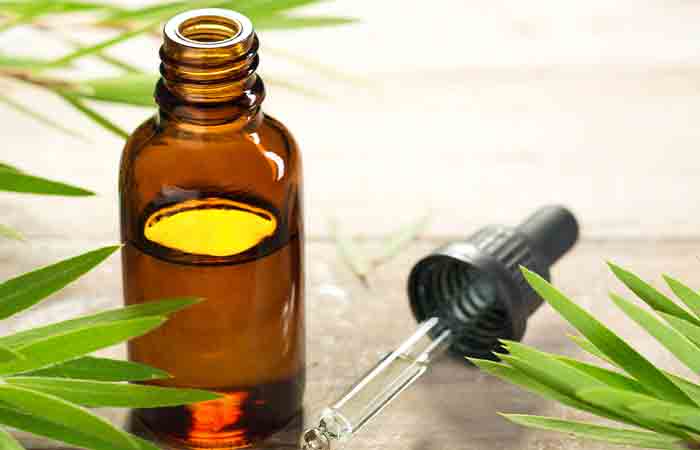
If it is an existing keloid, no, tea tree oil cannot treat it.
You will find plenty of articles on the internet that claim that tea tree oil can treat keloid scars. However, there is no sscientific proof in dermatology to back the claim. Scars, be it keloids or any other type of scars, are tough to remove, even after professional treatment. You can only minimize their appearance.
However, tea tree oil can help reduce the risk of developing keloid scars. Any wound needs proper healing. If it doesn’t heal properly, it may leave a scar. Tea tree oil can promote proper healing of your wound and help minimize the chances of developing a keloid scar.
This is primarily because:
- Tea tree oil has antimicrobial and anti-inflammatory properties (3). This means it can prevent infections and reduce inflammation, aiding proper wound healing.
- Tea tree oil also has antiseptic properties (4). Fresh cuts and wounds are prone to infection, which can delay the healing process and increase your risk of scarring. Tea tree oil can prevent the growth of microbes and heal the wound faster.
Whether you have got a piercing (on nose, chest, earlobes, etc.) or acne, cuts, and wounds, these properties of tea tree oil can help:
- Prevent fungal infection
- Reduce inflammation, including redness and irritation
- Minimize the pus-filled bumps and pustules that you might have developed
 Trivia
TriviaShana Diggs, a YouTuber, shared her experience of using tea tree oil to get rid of the keloids she developed after her piercings. She said, “Put it on there twice a day. A week and a half later, I was keloid-free (i).”
If you have any cuts, wounds, or injury, you may take preventive measures by using tea tree oil. However, none of the studies are conclusive, so be careful while using the oil. Scroll down to find ways to use tea tree oil to prevent keloid scars.
How To Use Tea Tree Oil For Preventing Keloids
Note: Undiluted tea tree oil is very potent. Dilute it with any carrier oil (jojoba, almond, olive, or virgin coconut oils) before using it.
For all the following recipes, mix 2-3 drops of tea tree oil in a tablespoon of any carrier oil and then use the blend. Follow the same proportion for all essential oils.
Also, do not apply any of these concoctions on an open wound. Once the wound starts healing, use the recipes to speed up healing and prevent keloids.
1. Tea Tree Oil And Sea Salt

Sea salt has antimicrobial properties (5). It helps keep the infection at bay. Aloe vera has antibacterial properties (6). Together with tea tree oil, it helps to contain inflammation and infection and promote proper healing.
You Will Need
- 1 teaspoon sea salt
- 2 tablespoons water
- Diluted tea tree oil
- 1/2 teaspoon aloe vera gel
- Cotton pad
Method
- Heat the water and stir the sea salt into it until it dissolves.
- Dip a cotton pad in this solution and tape it on the affected area.
- Let the keloid soak for about 5 minutes.
- Remove the cotton pad and apply the diluted tea tree oil.
- Wait for 5 minutes until the tea tree oil is absorbed and then apply the aloe vera gel.
How Often
Once-daily.
2. Aspirin And Tea Tree Oil
Aspirin is said to have an analgesic effect (7). This combination of aspirin and tea tree oil may help in easing pain and speeding up healing.
You Will Need
- 4 aspirin tablets
- 1/2-1 teaspoon water
- Diluted tea tree oil
Method
- Crush the aspirin tablets and add a few drops of water. Mix until you get a smooth paste.
- Apply this paste to the wound and leave it on for 15-30 minutes until it dries.
- Wash the paste off with water and follow this up by dabbing diluted tea tree oil on the area.
How Often?
Once a day.
3. Lavender And Tea Tree Oil
Tea tree oil helps eliminate the infection, while lavender essential oil’s anti-inflammatory properties can help reduce inflammation in the affected area (8).
You Will Need
- Diluted tea tree oil
- Diluted lavender essential oil
Method
- Mix equal parts of lavender and tea tree oil.
- Apply this blend to the keloid until it is completely covered.
- Leave the oil on as you would a topical ointment.
How Often?
Every day.
4. Tea Tree Oil And Vitamin E
Vitamin E is one of the richest sources of antioxidants and helps keep the skin moisturized (9). This is very important for proper healing and preventing scarring.
You Will Need
- 1/2 teaspoon diluted tea tree oil
- 1/2 teaspoon vitamin E oil
Method
- Mix equal parts of tea tree oil and vitamin E.
- Apply this oil mixture onto the affected areas.
- Leave the mixture on as you would a topical ointment.
How Often?
Every day.
5. Tea Tree Oil And Petroleum Jelly
Applying petroleum jelly on the wound site increases the moisture levels of the area, which is crucial for proper wound healing. Massaging the area gently may help in proper healing (10). It may also help prevent scarring or keloid development.
You Will Need
- ½ teaspoon diluted tea tree oil
- 1 teaspoon petroleum jelly
Method
- Mix both the ingredients.
- Massage the mixture on the affected area.
- You may wash it off after an hour or leave it on.
How Often
Once every day.
6. Tea Tree Oil And Coconut Oil
Virgin coconut oil moisturizes and protects the skin and reduces inflammation (11). Together with tea tree oil, it can help heal the skin and prevent scarring.
You Will Need
- 2-3 drops of tea tree oil
- 1 tablespoon virgin coconut oil
Method
- Mix both the oils.
- Massage the blend on the wound site.
- Leave it on as an overnight treatment.
How Often
Once every day.
These remedies may help in better scar or keloid management. However, using tea tree oil comes with a few risk factors that you should be aware of.
Risks Or Side Effects Of Using Tea Tree Oil For Keloids
Although tea tree oil is harmless, it may cause an allergic reaction due to which you may develop:
- Redness
- Itchy skin
- Rashes
- Hives
Hence, it is recommended that you do a patch test before using tea tree oil or any other essential oil on your skin. If you develop an allergic reaction, visit a doctor without any delay and avail treatment.
Accepting and flaunting your scars is the ultimate act of self-love. However, if your keloid is bothering you, try any of the natural remedies discussed above to minimize its appearance. You may opt for surgical removal or laser treatment. Discuss the pros and cons of the methods with your doctor and be aware of your eligibility for the treatment options.
Infographic: Top 5 Tea Tree Oil Combinations For Keloids
Keloids can be painful, and in case of inflammation, may take long to heal. Whether you are concerned about your appearance or bothered by the pain, you can deal with keloids with natural home remedies. Tea tree oil is a natural remedy enriched with anti-inflammatory and healing properties that you can mix with other ingredients to increase its potency. Read on to know more!

Illustration: StyleCraze Design Team
Keloids are smooth and raised scar tissues that form on the site of injury when the wound is healing. They are harmless but may cause itching, irritation, or tenderness. If you are looking for natural alternatives, tea tree oil for keloids is one of the most popular home remedies out there. Its anti-inflammatory and antimicrobial properties may reduce inflammation, prevent infection, and reduce the appearance of the keloid, thus working as a natural therapy. Mixing tea tree oil with lavender or coconut oil may prevent keloid scarring. Ensure you perform a patch test before using tea tree oil as it may cause an allergic reaction. If you develop an allergic reaction, consult your doctor immediately.
Frequently Asked Questions
What is the fastest way to get rid of a keloid?
Surgical removal and laser treatment are the fastest ways to get rid of keloids.
How do you use tea tree oil on piercing bumps?
Dilute 2-3 drops of tea tree oil with any carrier oil and then apply o the bump.
Can tea tree oil make keloids worse?
No. However, if you are allergic to it, it may cause skin reactions.
Does tea tree oil leave dark spots?
No, currently there are no studies that suggest that applying tea tree oil can cause dark spots.
Can massaging a keloid flatten it?
Anecdotal evidence suggests that massaging a keloid may help break down the tissue as it forms. This may result in flattening the keloid. However, studies are warranted to understand this further.
Can keloids be cancerous?
No, keloids are not cancerous and do not have any drastic effect on physical well-being in general. However, patients with keloids are at a high risk of developing skin cancer. If the scar on your body is uneven, turns white or blue or starts to bleed, consult a doctor immediately (13).
Key Takeaways
- Due to its capacity to lower inflammation and encourage healing, plant-based tea tree oil is beneficial in treating keloids.
- Administer tea tree oil topically to the afflicted area after diluting it with a carrier oils, such as coconut oil.
- You can also use tea tree oil with other essential oils like lavender or frankincense for more skin advantages.
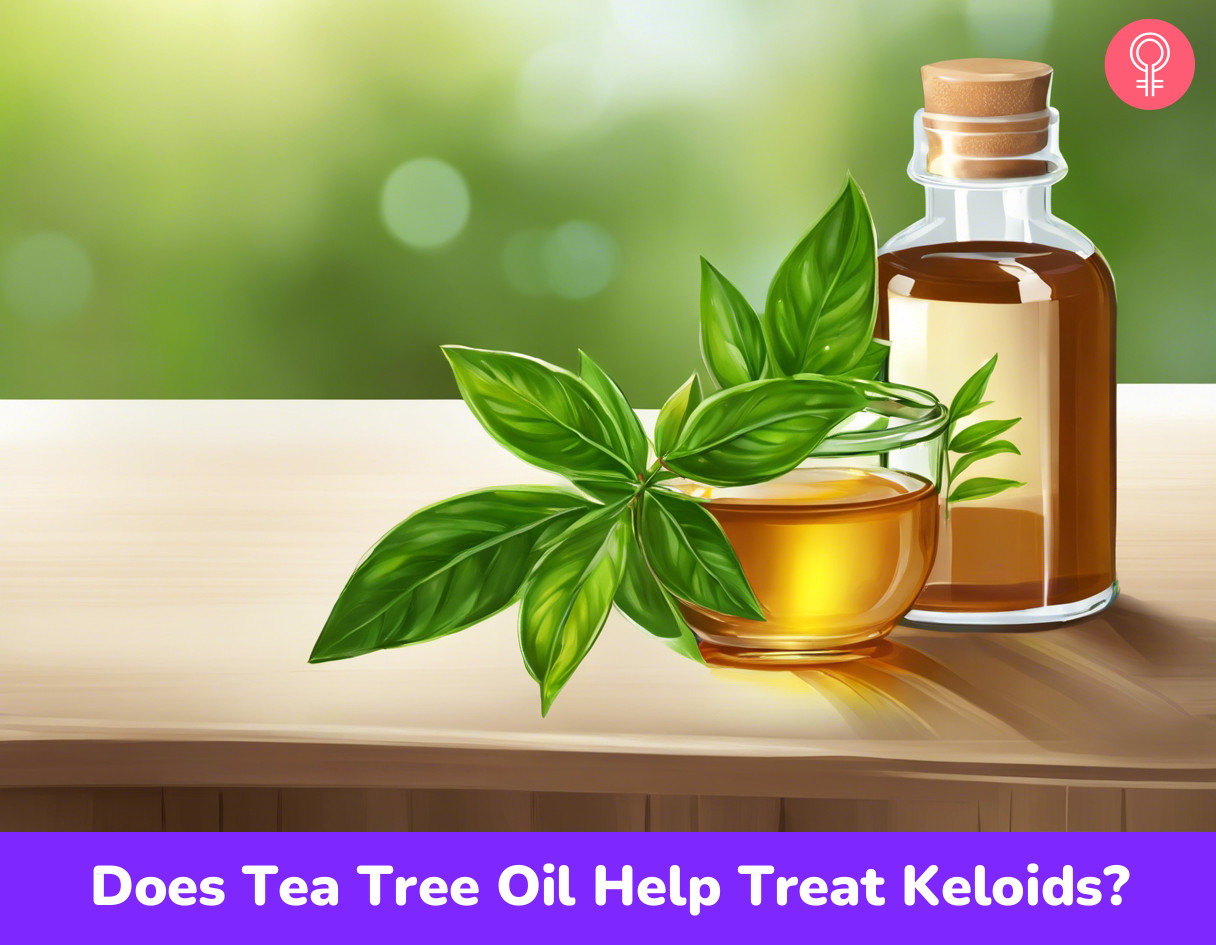
Image: Stable Diffusion/StyleCraze Design Team
References
Articles on StyleCraze are backed by verified information from peer-reviewed and academic research papers, reputed organizations, research institutions, and medical associations to ensure accuracy and relevance. Read our editorial policy to learn more.
- Biological significance of genome-wide DNA methylation profiles in keloids, Henry Ford Health Scholarly Commons.
https://scholarlycommons.henryford.com/cgi/viewcontent.cgi?article=1080&context=otolaryngology_articles - Hypertrophic Scarring Keloids
https://www.ncbi.nlm.nih.gov/books/NBK537058/ - Melaleuca alternifolia (Tea Tree) Oil: a Review of Antimicrobial and Other Medicinal Properties, Clinical Microbiology Reviews, US National Library of Medicine, National Institutes of Health.
https://www.ncbi.nlm.nih.gov/pmc/articles/PMC1360273/ - The Influence of Tea Tree Oil (Melaleuca alternifolia) on Fluconazole Activity against Fluconazole-Resistant Candida albicans Strains, BioMed Research International, Hindawi.
https://www.hindawi.com/journals/bmri/2015/590470/ - Antimicrobial properties of salt (NaCl) used for the preservation of natural casings. Food Microbiology, US National Library of Medicine, National Institutes of Health.
https://www.ncbi.nlm.nih.gov/pubmed/16943065 - Aloe Vera: A Short Review, Indian Journal of Dermatology, US National Library of Medicine, National Institutes of Health.
https://www.ncbi.nlm.nih.gov/pmc/articles/PMC2763764/ - A randomized parallel trial of topical aspirin-moisturizer solution vs. oral aspirin for acute herpetic neuralgia. International Journal of Dermatology, US National Library of Medicine, National Institutes of Health.
https://www.ncbi.nlm.nih.gov/pubmed/11703529 - Effect of Lavender (Lavandula angustifolia) Essential Oil on Acute Inflammatory Response, Complementary and Alternative Therapies for Inflammatory Diseases, Hindawi.
https://www.hindawi.com/journals/ecam/2018/1413940/ - Vitamin E and Skin Health, Linus Pauling Institute, Oregon State University,
https://lpi.oregonstate.edu/mic/health-disease/skin-health/vitamin-E - Update on Postsurgical Scar Management, Seminars in Plastic Surgery, US National Library for Medicine, National Institutes of Health.
https://www.ncbi.nlm.nih.gov/pmc/articles/PMC4961501/ - In vitro anti-inflammatory and skin protective properties of Virgin coconut oil, Journal of Traditional and Complementary Medicine, US National Library of Medicine, National Institutes of Health.
https://www.ncbi.nlm.nih.gov/pmc/articles/PMC6335493/ - Keloid, US National Library of Medicine, National Institutes of Health.
https://www.ncbi.nlm.nih.gov/books/NBK507899/ - Risk of cancer development in patients with keloids, Scientific Reports, Nature.
https://idp.nature.com/authorize?response_type=cookie&client_id=grover&redirect_uri=https%3A%2F%2Fwww.nature.com%2Farticles%2Fs41598-021-88789-1#:~:text=The%20incidence%20of%20skin%20cancers,%25%20CI%201.08%E2%80%934.42).










